 |
||
| HOME | ||
 |
||
| Acute Myelogenous Leukemia (AML) |
||
 |
||
| Other Leukemia Types (ALL / CLL / CML / HCL) |
||
 |
||
| Myelodysplastic Syndrome | ||
 |
||
| Symptoms and Diagnosis | ||
 |
||
| Leukemia Treatment Options | ||
 |
||
| " Chemotherapy | ||
 |
||
| " Blood Stem Cell Transplants | ||
 |
||
| " Radiation and Surgery | ||
 |
||
| " Chemo Side Effects | ||
 |
||
| " Clinical Trials Info | ||
 |
||
| " Coping with Leukemia | ||
 |
||
| " What to Ask Your Doctor | ||
 |
||
| Financial Assistance | ||
 |
||
| At Risk Jobs/Exposure | ||
 |
||
| Leukemia Resources | ||
 |
||
| Survivor's Story | ||
 |
||
| Leukemia News | ||
 |
||
|
Search for information:
|
||

|
Leukemia Cancer News - Return to Menu Higher Cumulative Doses of Epirubicin and Cyclophosphamide for Early Breast Cancer Associated with Increased Risk of Developing Leukemia According to a recent article published in the Journal of Clinical Oncology, higher cumulative doses of the chemotherapy agents epirubicin (Ellence®) and cyclophosphamide (Cytoxan®) in the treatment of early breast cancer are associated with a higher incidence of developing acute myeloid leukemia (AML) and myelodysplastic syndromes (MDL). However, the overall risk of developing acute myeloid leukemia or myelodysplastic syndromes remains small in this group of patients. It is important for patients to discuss the individual benefits and risks of their treatment regimen for breast cancer. Breast cancer is diagnosed in approximately 250,000 women annually in the United States alone. Early breast cancer, or cancer that is confined to the breast or axillary (under the arm) lymph nodes, has high cure rates following standard therapies. Chemotherapy following the surgical removal of cancer (adjuvant therapy) is commonly used in early breast cancer to kill any cancer cells that may remain in the body following surgery. Epirubicin and cyclophosphamide are two chemotherapy agents used in adjuvant therapy for breast cancer. A risk associated with some chemotherapy agents is the development of subsequent (secondary) cancers, such as AML or MDSdiseases that affect blood cells. Evaluations of specific chemotherapy agents and their possible association to the development of secondary cancers continue. Cumulative doses (total dosage over the period of time of treatment) are also being investigated as possible risk factors. Researchers from Europe recently reviewed data from 19 randomized clinical trials that evaluated the chemotherapy agents epirubicin and cyclophosphamide as part of an adjuvant treatment regimen for breast cancer. Over 7,100 patients were treated with epirubicin; 92 percent of whom were also treated with cyclophosphamide. At a follow-up of 8 years, 0.37 percent of patients who received standard doses of both epirubicin and cyclophosphamide developed AML or MDS. However, patients who received higher overall cumulative doses of both epirubicin and cyclophosphamide had an increased incidence of AML or MDS of almost 5 percent at 8 years. The researchers concluded that cumulative above-standard doses of both epirubicin and cyclophosphamide used as adjuvant therapy increase the risk of development of AML or MDS in women with early breast cancer. Patients with breast cancer are encouraged to speak with their physician regarding their individual risks of long-term side effects with their chemotherapy regimen. Reference: Praga C, Bergh J, Bliss J, et al. Risk of Acute Myeloid Leukemia and Myelodysplastic Syndrome in Trials of Adjuvant Epirubicin for Early Breast Cancer: Correlation With Doses of Epirubicin and Cyclophosphamide. Journal of Clinical Oncology 2005; 18: pp. 4179-4191 Supreme court asks for business, lawyers groups opinion The Alabama Supreme Court has asked the Alabama Trial Lawyers Association and the Business Council of Alabama for "friend-of-the-court" briefs on the time limit plaintiffs have to file a lawsuit, known as the statute of limitations. It is unusual, according to observers, because the justices already heard arguments in person from the lawyers in the case. Robert Esdale, the clerk of the Supreme Court, said the justices usually do not request briefs after oral arguments. Jack Cline, a retired chemist from Vance, contends he developed a rare form of cancer after years of exposure to benzene while working for a railroad wheel manufacturer. A Jefferson County judge ruled in favor of the defendants, Ashland Inc., Chevron Phillips Chemical and ExxonMobil Corp., after determining that Cline missed a two-year window for filing the suit. Under a 1979 landmark case, that two-year time limit starts from the time a person has been exposed to the toxics. Under a separate precedent, people cannot sue until after they have suffered actual harm; lawsuits over potential future damages are impermissible. As a result, Cline and thousands of other people with diseases that have a long latency period effectively are barred from seeking compensation in court. Lawyers for both sides made their cases to the Supreme Court on April 4. The justices last week gave the Business Council and the Trial Lawyers Association until May 11 to submit their opinions. The attorneys will then have 15 days to respond. "I'm not really sure how to take it. I think it means they're concerned about the issue and want to make sure they get it right," said Robert Palmer, who represents Cline and has argued that no other state so severely restricts lawsuits by people made ill by toxic chemicals. George Walker, a Mobile lawyer who represents the defendants, said he remains confident the court will uphold the original judge's ruling. "I really don't know what to make of it one way or the other, except to say that I think they want to take care with it," he said. Cline, 67, retired from Griffin Wheel in 1995, after a 37-year career with the firm. During those years, he said, he used benzene to clean oxygen valves before they were installed in the furnaces. Under present rules, the latest Cline would have had to file a lawsuit would have been 1997. But it was not until 1999 that he was diagnosed with acute myelogenous leukemia, a fatal form of cancer that researchers say is caused by exposure to radiation or benzene. On Tuesday, Cline said he views the request for briefs as a positive sign, if for no other reason than it keeps the issue alive. "That right there is a big difference. People in this state don't know about their laws," he said. "Any sign toward movement is a good sign." Steve Prince, a spokesman for the Trial Lawyers Association, said his organization is reviewing the matter. In general, he said, the group supports changing the rule. "The current position that has been adopted means that for people who have been exposed to toxic substances and develop illnesses that might not show up for decades, it keeps them from having access to the courts," he said. Representatives form the Business Council of Alabama were not available for comment Tuesday. |
|
|


